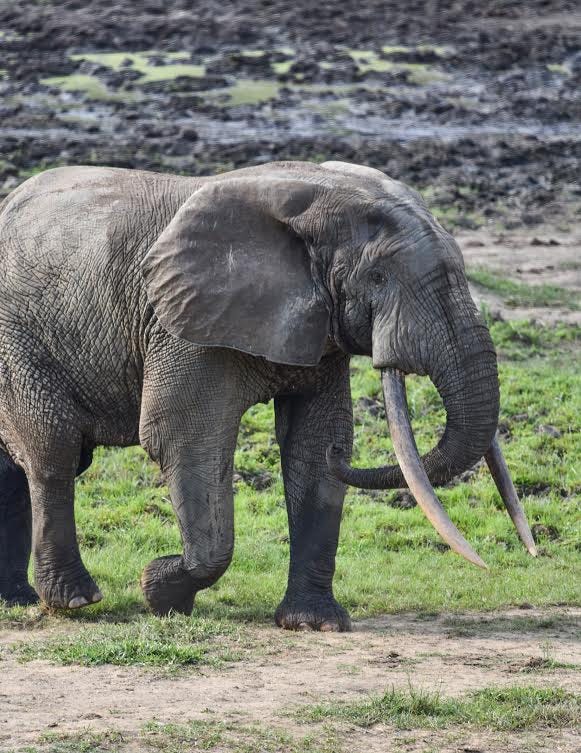Musth: Elephant Man Periods
Dr. Tatiana briefly discussed 'musth', a period of time in which a male elephant is afflicted with extremely high spikes in testosterone. These spikes, which can last anywhere from a few days at a time to four months, have strong influences on the male's behavior. Dr. Tatiana mentions that it can increase aggression and cause males to pick fights with other males. Fights can get so intense, that one male gets killed. Usually they end with one male chasing the other off for several miles.

'Musth and its effects of on male-male and male-female associations in Asian elephants' notes that musth is a roving behavior. Female elephants live a completely different lifestyle than male elephants. Females spend their entire lives in their natal clan, whereas males usually break off from their clans during puberty and live in solitude for the rest of their lives. Females also have a very short period of time where they are able to reproduce because they take 10 years to sexually mature, and because they spend 4-5 years caring for their offspring after they become pregnant. These factors cause competition between males to be very intense. Musth does not necessarily increase the amount of sex a male elephant is having in Asian elephants. Musth is expensive to maintain and can strongly affect body condition.
This specific paper had 5 questions it wanted to answer. to examine how musth is affected by male age (with the assumption that older males having a higher probability of being in musth). The turnover rate of males in musth and males not in musth and whether the males that entered the area in study were in musth or not. Whether musth affects male association with females. How musth status could affect the time males were spending in all-male groups and if female presence affected the associations of the males. It also sought to see whether musth status and age affected the spatiotemporal distribution of males. Males were observed in Nagarahole and Bandipur and parameters for age and the elephant being in musth were defined. It was found that musth males were in between 14 and 56 years old and that older males tended to be the ones sighted in musth (Figure 1). While the percentage of males sighted in musth was much higher in new males than among the resident males in all three age-classes, the goodness of fit values were not statistically significant. Although this is not statistically significant, the findings are still consistent with the belief that musth is a roving strategy. Young males seem to spend a smaller proportion of their time in musth with groups of females. Older males associated with female groups when in musth versus when they were not in musth. A possible reason for this could be because of younger males being perceived as a threat by older males. While there was an avoidance of males in musth in direct association, there was not an avoidance of males in musth at a spatiotemporal scale.

Figure 1. The number of percentage of males sighted in musth and their ages. It was more common to see older males in musth. There were 156 males used to compile this graph and they were only counted one time. The males were defined at the midpoint of the study. We see the great decrease in populations, but it still shows us that as age increase, musth does seem to be more commonly observed.
Overall, this study supported the belief that musth is a roving behavior and that there seems to be more benefits for older males to be in musth rather than younger males in musth. Young males have been observed sneaking in and mating with females when they were not in musth with some success.
Keerthipriya, P., Nandini, S., Gautam, H., Revathe, T., & Vidya, T. (2019, December 05). Musth and its effects ON MALE–MALE And male–female associations in Asian elephants. Retrieved April 13, 2021, from https://academic.oup.com/jmammal/article/101/1/259/5658421?login=true
This idea of musth in elephants also stood out to me when reading these chapters. I even wrote in my notes "omg, this is like a man period or menopause" so your title of this post caught my attention. I think it is interesting that females tend to want to avoid males in musth and the process is very energy-expensive as well as dangerous and it still leaves me with more questions about the benefits and costs of musth in older males.
ReplyDeleteThis is super interesting, and I think it makes sense that older males seem to benefit more from being in musth since they're likely to be bigger than the younger males. Bigger males are more likely to win fights, so you would expect them to be the ones who benefit from the extreme aggression that comes with musth. Do you think it could also offer an explanation for why older males tend to be in musth longer?
ReplyDeleteHi Shelby! Thank you for your question! I definitely think this could offer an explanation for why older males tend to be in musth longer. Older males tend to have the size advantage on younger males (which we learned in Dr. Tatiana's book), so being larger and more aggressive is costly but definitely more advantageous. Older males are able to hang around groups of females for longer as well, so the musth would give them more of an advantage in those terms as well.
Delete